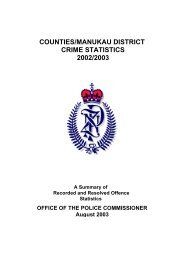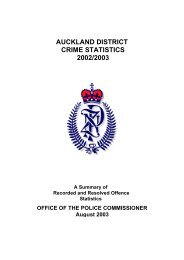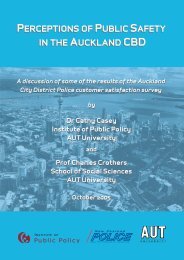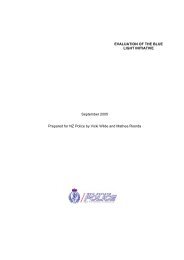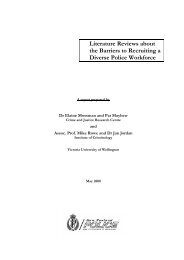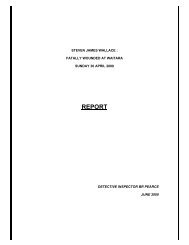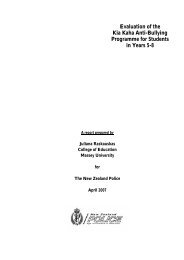Police Perceptions of Maori - Rethinking Crime and Punishment
Police Perceptions of Maori - Rethinking Crime and Punishment
Police Perceptions of Maori - Rethinking Crime and Punishment
You also want an ePaper? Increase the reach of your titles
YUMPU automatically turns print PDFs into web optimized ePapers that Google loves.
(factors) in a set <strong>of</strong> data, was carried out. It showed that either a two factor or a one<br />
factor solution could be considered as best representing the data. The two factor<br />
solution 14 produced the two clusters <strong>of</strong> items shown in Table 10 below.<br />
Table 10<br />
Two clusters <strong>of</strong> items from a factor analysis <strong>of</strong> 9 items relating to<br />
<strong>Maori</strong> political aspirations showing the amount <strong>of</strong> variance 15<br />
associated with each item with each cluster; N=628<br />
Items R squared with:<br />
Own cluster = Other cluster =<br />
Cluster 1: Cluster 1 Cluster 2<br />
Give <strong>Maori</strong> back ancestral l<strong>and</strong>s<br />
taken by the Crown .50 .30<br />
Give <strong>Maori</strong> guardianship <strong>of</strong> native plants .58 .50<br />
Develop a separate justice system for <strong>Maori</strong> .42 .07<br />
Be more responsive to cultural difference in<br />
the justice system .54 .22<br />
Restore <strong>Maori</strong> fishing rights .67 .27<br />
Own cluster = Other cluster =<br />
Cluster 2 Cluster 2 Cluster 1<br />
Settle Waitangi Treaty claims .45 .32<br />
Honour the <strong>Maori</strong> language .65 .20<br />
Respect <strong>and</strong> preserve <strong>Maori</strong> customs .69 .16<br />
Improve the social <strong>and</strong> economic<br />
condition <strong>of</strong> the <strong>Maori</strong> people .50 .20<br />
The two clusters in Table 10 could be interpreted as pointing to a difference in their<br />
acceptability to different people. It is possible that the first cluster represents items on<br />
which there were a variety <strong>of</strong> different opinions whereas the second cluster represents<br />
items which were regarded as part <strong>of</strong> what has been accepted by most New Zeal<strong>and</strong>ers.<br />
This interpretation is certainly supported by the finding that, on average, 65% <strong>of</strong> the<br />
sample disagreed with the cluster 1 items while only 12% disagreed on average with<br />
the cluster 2 items. On the other h<strong>and</strong>, it is important to recognise that the two<br />
clusters were not totally independent <strong>of</strong> one another; both clusters were moderately<br />
correlated with one another (r=0.60). Furthermore all the items can be seen as having<br />
a relationship with the single main factor 16 as shown in Table 11 below <strong>and</strong> this factor<br />
accounted for 95% <strong>of</strong> the variance in the correlation matrix.<br />
Table 11<br />
Relationship among 9 items relating to <strong>Maori</strong> political aspirations as<br />
shown by the loadings on the first factor 17 ; N=628<br />
Item<br />
Factor loading<br />
Restore <strong>Maori</strong> fishing rights .72<br />
Give <strong>Maori</strong> back ancestral l<strong>and</strong>s<br />
14 This was derived from a principal component cluster analysis which is similar to the principal<br />
component factor analysis but is used for separating out distinct clusters <strong>of</strong> items.<br />
15 The variance is a measure <strong>of</strong> the proportion <strong>of</strong> variability in the data that can be attributed, in<br />
this instance, to the cluster where the total amount <strong>of</strong> variance is 1.00. Thus R-squared = .50<br />
indicates that about half the variability in the item on ancestral l<strong>and</strong>s goes with the other items<br />
in the first cluster.<br />
16 The first unrotated principal component for the principal components analysis.<br />
17 The factor loading can vary from 0 to 1.00. The larger it is, the greater the extent to which<br />
each item is being responded to in a common way.<br />
21



